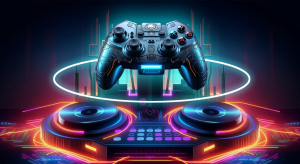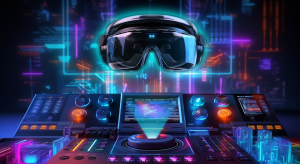What do you think makes a game memorable? As gaming technology evolves, we have many great games in terms of graphics and gameplay. But a few years from now, the memories get clouded- courtesy of the abundance of similar-looking gameplays.
What withstands the test of time is the unique experiences and sensations the game offers. If we delve deeper, our emotion about the game gets directly related to its ambient sound and music.
That is the power sound design holds. The same sound can convey a variety of emotions based on the scenario. It can trigger anger, pain, happiness, delight, and everything you want to get conveyed through the game. Even the lack of sound is a sound when rightly implemented.
Similarly, even minor reasons can lead to disruptive sound design in games. A repetitive NCP or an unnecessary sound that adds no value to the game mechanics or engagement can as well get your game shelved once a gamer completes all levels.
Let us study the impact and value of sound design in games that make it a necessary element.
The first ever video game with sound was Pong in 1972. The only sounds you would get were blips and bloops- simple yet effective to give feedback to the players on the ball’s bounce. Or take the example of Super Mario Bros.– anyone familiar with the game can hum the theme music that remains as iconic as Mario’s overalls.
Games from the 70s and 80s were simple, even basic compared to games today. But they were fun back then because availability was limited and the simple sound effects aptly matched the simplicity of the games.
Storage constraints and slow processors were the main hindrances to getting more experimental with sound. But the advent of CD-ROMs and eventual rapid technological evolutions made storage spaces larger and more affordable- allowing scope to get more experimental with sound design in games and music.
Today, we have come a long way and have games with cinematic music, sound design, and even dynamic game music.- that adjust as per the gameplay and player’s action.

The sound design in games is fundamentally different from the game audio track. Instead, it is a part of the audio track. The design involves fleshing out all the sound elements that create the ambiance of the game and makes it immersive.
Their duration, intensity, and placement- all are part of the sound design process. Striking the right balance is the key to creating masterpieces that give the most immersive experience to gamers and make it memorable.
Here are the different things sound design does to elevate the gameplay experience:
Imagine playing a game like Temple Run sans sound or with a ballad or lullaby in the background- would it feel as fun anymore? The upbeat background music induces the adrenaline rush of the journey-egging you forward. The background music and sound effects altogether contribute to setting the right mood for the game. It enthuses the player even before reaching the more interesting levels.
Upbeat music in rhythm with the action, or melodious serenade when you explore a fairyland terrain in the gaming world- all sets the right mood for the players.
Approximately 83% of adult gamers list sound as one of the most important video game console elements, according to Gaming Technology Study 2006, conducted by Consumer Electronics Association.
The sound design can create the atmosphere intended by the game.
A classic example would be the game Silent Hills 2. The game has eerie graphics, fit for a survival horror game. But what truly brings the vibe alive are the sound effects and dreading and heavy background score. The game creates a prolonged sense of foreboding with simple sound effects.
Creaky floorboards, the gradual sound of hooves on grass, and distant thuds- all these together induce the right amount of giddiness, delight, and adrenaline rush that keeps the players hooked even when they get scared. The result is an immersive ambiance where the players are transported within the virtual world.
The sound effects occasionally set the course of the narrative. It contributes to the realism of the game. Sound of the player’s movement, using a specific weapon, impact noise when you hit the target- all these take the narrative forward and make the game more immersive. Occasionally, the sound design in the game is used to depict the turning point in the narrative too.
Another major impact of audio design for video games is its role as an emotional trigger. A good game development studio can create immersive sound effects that evoke a myriad of emotions among users. The sound effects can convey the player’s emotional state based on the narrative.
The use of binaural audio techniques in Hellblade: Senua’s Sacrifice portrays the protagonist’s struggle with psychosis. It also immerses the players and makes them at one with the protagonist’s struggle using haunting voices. The team worked with neuroscience and mental health experts to design the haunting sound effects that can make players feel the protagonists’ emotions as their own.
Emotional triggers can be in different forms. Exciting and pumped-up music can make you feel energetic during a chase or battle encounter. Cheering and clapping sounds after you complete a puzzle keeps you motivated. A melancholic melody along with a cut scene during the game storyline, further intensifies the sombre mood- just the way movies do.
The practical importance of sound design in games is in terms of gameplay feedback. Sound can help players perceive challenges before they see it on-screen. The sound effects can imply victory, defeat, and potential threats the players need to watch out for. Audio cues are useful hints at times that keep the players alert and focused.
Take the example of Prince of Persia: Warrior Within where, right before the “Dahaka” appeared, you would hear its growl and then the screen turns sepia during the chase with heavy metal music. Occasionally gameplay feedback can be in the form of dialogues too that guide the player’s decision. Paimon’s voice in Genshin Impact occasionally acts as guidance for the players in their quests.
A faint growl, the swoosh of a bullet, an object dropping from a height, the clanking of weapons, and footsteps- all act as feedback depending on the gameplay. It helps to improve the player’s performance as they get alerted at the right time to take the correct decision during gameplay.
The feedback also helps to set the pace of the gameplay.
“Audio serves, for instance, to alert the player to an upcoming event, or to forewarn the player of approaching enemies. Anticipating action is a critical part of being successful in many games, particularly adventure and action games. Notably, acousmatic sound— sound with no clear origin visually— may inspire us to look to the direction of a sound”- According to Karen Collins, in Game Sound: An Introduction to the History, Theory, and Practice of Video Game Music and Sound Design.
Sound cue associated with a timer keeps the players alert about the game’s time limit. Appropriate sound can induce a sense of urgency that instigates players to think and move fast during gameplay.
HellBlade: Senua’s Sacrifice is a classic example of how sound cues can be the primary clues for players. The game pushes the boundaries of audio design for video games in terms of setting the direction of narrative as well as gameplay with sound. The players get attached to the protagonist, her suffering and struggles that are perfectly expressed through her voice. The only cue players get about lurking monsters is their sound.
The game navigation and immersive nature also get improved by using sound design in games for inducing spatial awareness. Positional audio techniques are used to create spatial awareness through sound, such that it replicates a real-time environment. Such sounds help to navigate the game terrain better. 3D audio landscapes let the players perceive the distance between hurdles, the direction they need to go or the direction to avoid, and so on. Spatial audio is particularly useful in open-world games or RPG games where you are guided by a map through a vast terrain.

Game development companywork on creating realistic reflective sounds to define distance and help players navigate the name better. Such sound effects can also help players perceive the direction of in-game objects and events.
Spatial audio can also replicate the beauty of real-world physical spaces. Take the example of Diablo I- there are a variety of subtle audio elements in the background that contribute to creating the haunting ambiance of the game. It also helps you perceive your position in the game terrain. The distant sound of the sarcophagus opening, footsteps on dungeon floors, and the noise of picking up and dropping weapons on the way- all enhance the overall performance and experience of the players.
Another example is Cyberpunk 2077, which brings city life with spatial awareness through realistic sounds. You can hear a juxtaposition of distant cars passing, music from nightclubs, and chatters- all of which adds to the game’s realism.
Music also contributes to creating spatial awareness in a game. Fading or gradually increasing music induces a sense of transition in the gameplay. The importance of music in games is as much as sound design. They are interconnected. The sound design stands out for its passive contribution. You would not realize its contribution till good sound design is absent from the game. Imagine playing a game like God of War with just background music but no sound of the trolls you fight or rustling leaves in the forest or the sound of footsteps on different grounds!
The sound design in games is a crucial part though Akira Yamaoka, the composer behind the Silent Hills franchise observes,
“Game industry doesn’t take audio seriously enough.”
Every video game we remember fondly and those that never get old have a common element- good plot and graphics enhanced by apt sound effects. One cannot deny that a holistic approach to quality game development Company must value sound design as much as any other component of the video game design process.
When you consider the contribution that sound design has towards the best games of all time, one cannot deny the importance of sound design in games.
Juego Studios is one of the leading full-cycle game development companies. We cover every aspect of game development including sound design. Make your dream project a reality with the help of our talented professionals.
Get In Touch
Recent Posts